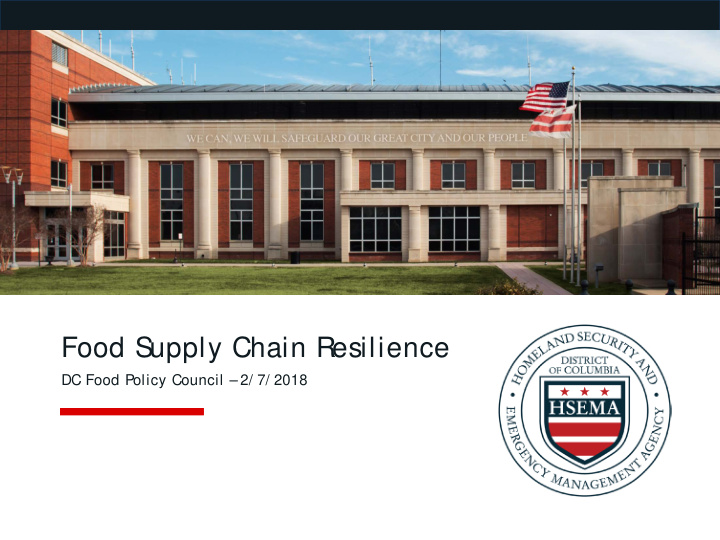



Food S upply Chain Resilience DC Food Policy Council – 2/ 7/ 2018
Background • S cope: analyze resiliency of Dist rict food supply chain (defined as “ a ct ivit ies associat ed wit h t he f low and t ransf ormat ion of goods f rom raw mat erials t o end-users” ) • Desired out come: underst anding of what is needed t o ensure availabilit y of food for Dist rict resident s following a cat ast rophic event • Principle invest igat or: DC Homeland S ecurit y and Emergency Management Agency (HS EMA) • Conduct ed under FEMA Technical Assist ance Program Food Supply Chain Resilience February 7, 2018 | 1
S tudy outline • Part I: Characterize the food supply chain - Identify risks and vulnerabilities - Complete by May 31, 2018 - • Part II: Conduct stakeholder outreach - Analyze capabilities of the supply chain for managing risk - Draw conclusions about level of resiliency - Make recommendations - Complete by (TBD) - Food Supply Chain Resilience February 7, 2018 | 2
Characterizing the District food supply chain • Describing supply chain component s: Demand nodes – where consumers obtain their food - Supply nodes – where food is staged for distribution - Demand-supply links – how food gets from supply node to - demand node • Using available dat a and informat ion: Existing DC data - Open source documents - Other j urisdiction plans - S upply chain impacts from recent catastrophic events - Food Supply Chain Resilience February 7, 2018 | 3
Food supply chain overview Food Supply Chain Resilience February 7, 2018 | 4
Identifying risks and vulnerabilities • Ident ifying t hreat s and hazards t hat could affect t he ent ire supply chain • Ident ifying vulnerabilit ies for each supply chain component • Modeling impact s from a cat ast rophic hurricane scenario Food Supply Chain Resilience February 7, 2018 | 5
S ome key questions • Where are the primary food distribution centers? • What are the key transportation routes for food delivery into the District? • What is the breakdown of where DC residents get their food, by source (demand node)? • Which supply chain components are in high-hazard areas? How many of these are in low income/ food insecure areas? • What are the key interdependencies with other sectors such as transportation, fuel, water, power, and communications? • How is the food supply chain evolving? How will this affect its resilience? Food Supply Chain Resilience February 7, 2018 | 6
How we can use the results • Conduct furt her analysis t o validat e findings and det ermine level of resiliency • S t rengt hen exist ing emergency operat ions plans, including integrating the food sector into existing emergency plans and exercises. • Leverage stakeholder outreach (private sector) by building relationships and identifying ways to support them during emergency events. • S upport ot her policy and planning init iat ives (DC Food Policy, Resiliency Office, MWCOG Food Value Chain, neighboring j urisdict ions out side NCR) Food Supply Chain Resilience February 7, 2018 | 7
HS EMA Proj ect Team • S haron Frederick, Proj ect Manager sharon.frederick@ dc.gov • Mark S cot t , Proj ect Lead mark.scot t @ dc.gov • Chelsea (Y oung) Love, Proj ect Analyst chelsea.young@ dc.gov • Mildred Mudambo, Proj ect Analyst (cont ract or) mildred.mudambo@ dc.gov Food Supply Chain Resilience February 7, 2018 | 8
Recommend
More recommend